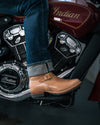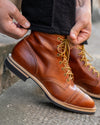Product Description
Made by Wesco® Boots
Traditional work and engineer boots from the USA, handcrafted in Scapposse, Oregon.
Wesco® - 10" Horsehide Engineer Boot - Brown. The "Mister Lou"
- 10" engineer boot built on the MP 1339 last
- Brown Maryam veg-tanned horsehide leather
- Slim leg shaft to fit under slimmer jeans
- A narrower heel pocket (thank other Wesco® engineer boots) to reduce heel slip
- Dr. Sole Brown half outsole and heel
- Motor Patrol toe
- 1 1/2" heel
- Solid brass roller buckles
- Vintage Engineer triple stitching on uppers
- Double stitching on outsole
- V-stitched backstay
- Waxed edges on midsole and heel stacks
- Leather inserts
Leather Care
Maryam Horsehide
- Maryam horsehides are sourced from the highly regarded Maryam Tannery, vegetable-tanning specialists based in Tuscany, Italy
- Horsehide is a dense, durable leather known for its toughness, wind resistance, and ability to break in over time without losing structural integrity. Compared to cowhide, it has a tighter grain and firmer feel, making it well-suited to outerwear like motorcycle and workwear jackets
- Over time, horsehide will develop character through creasing, darkening, and subtle patina. Unlike Shell Cordovan, it has a more textured surface and is less prone to fine scratching, though sharp abrasives can still scuff or gouge the finish
- Horsehide is typically treated during tanning with oils and waxes, giving it a degree of water resistance. We recommend conditioning only when the leather shows signs of dryness — about once or twice a year, depending on wear and climate. Use a neutral leather conditioner or balm sparingly, applying a small amount and buffing thoroughly. Avoid over-conditioning, as it can soften the leather excessively and affect its structured shape
- For cleaning, start with a soft, dry cloth to remove surface dust. For more thorough cleaning, use a slightly damp cloth with a drop of mild soap, and gently wipe down the jacket. Never soak the leather. If the jacket gets wet, blot gently and allow it to naturally dry at room temperature, away from heat sources. Once dry, a light buff with a soft cloth will restore its finish

Wesco Boots®, established in 1918, is a renowned American manufacturer of durable, handcrafted boots based in Scappoose, Oregon. Specialising in work boots for professions such as linemen, loggers, and wildland firefighters, Wesco® combines traditional craftsmanship with modern design.

Offering a range of styles and options, Wesco® footwear is built using the finest leathers, in combination with hardwearing Vibram® soles—ensuring that every boot is made to withstand the toughest conditions.